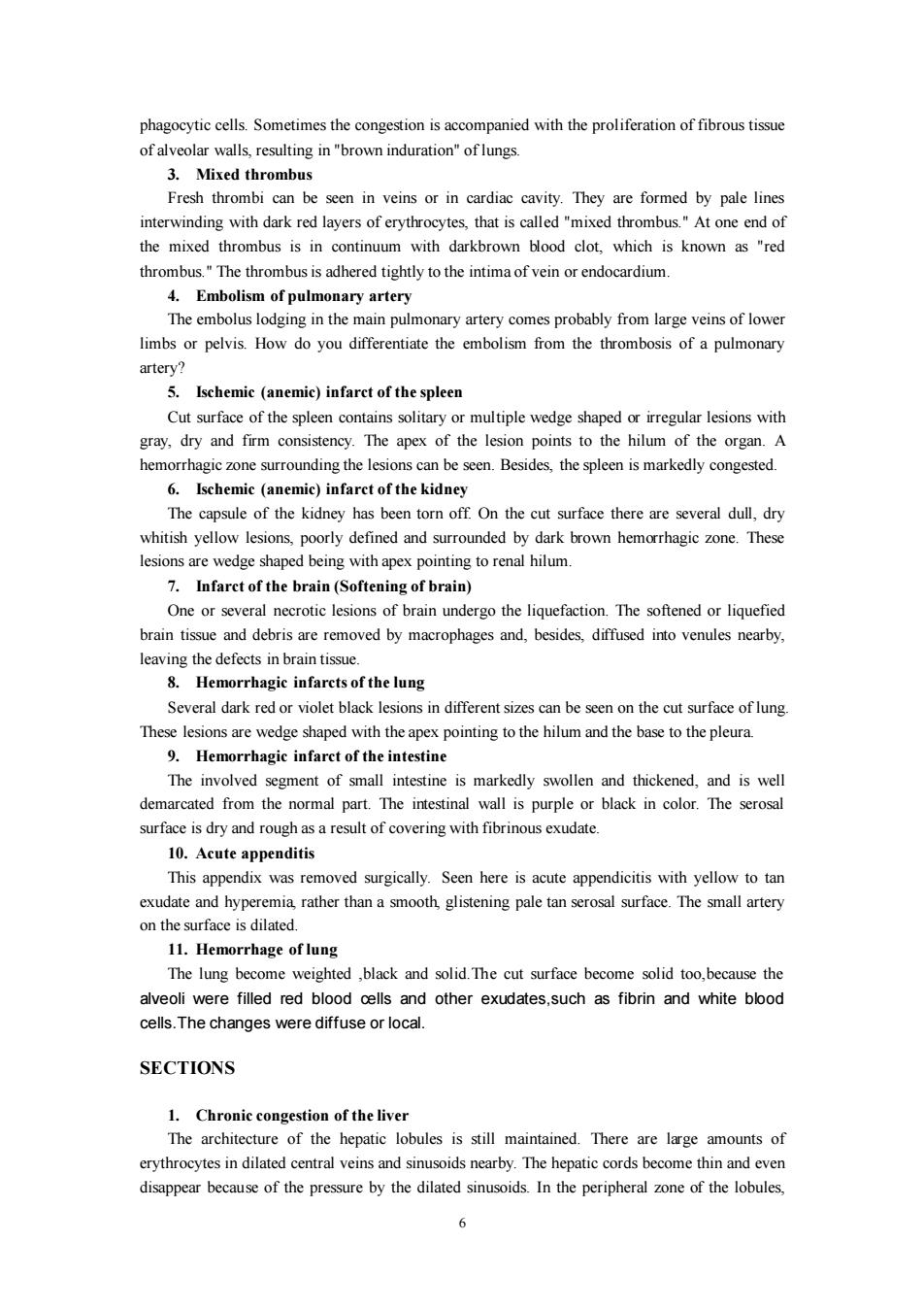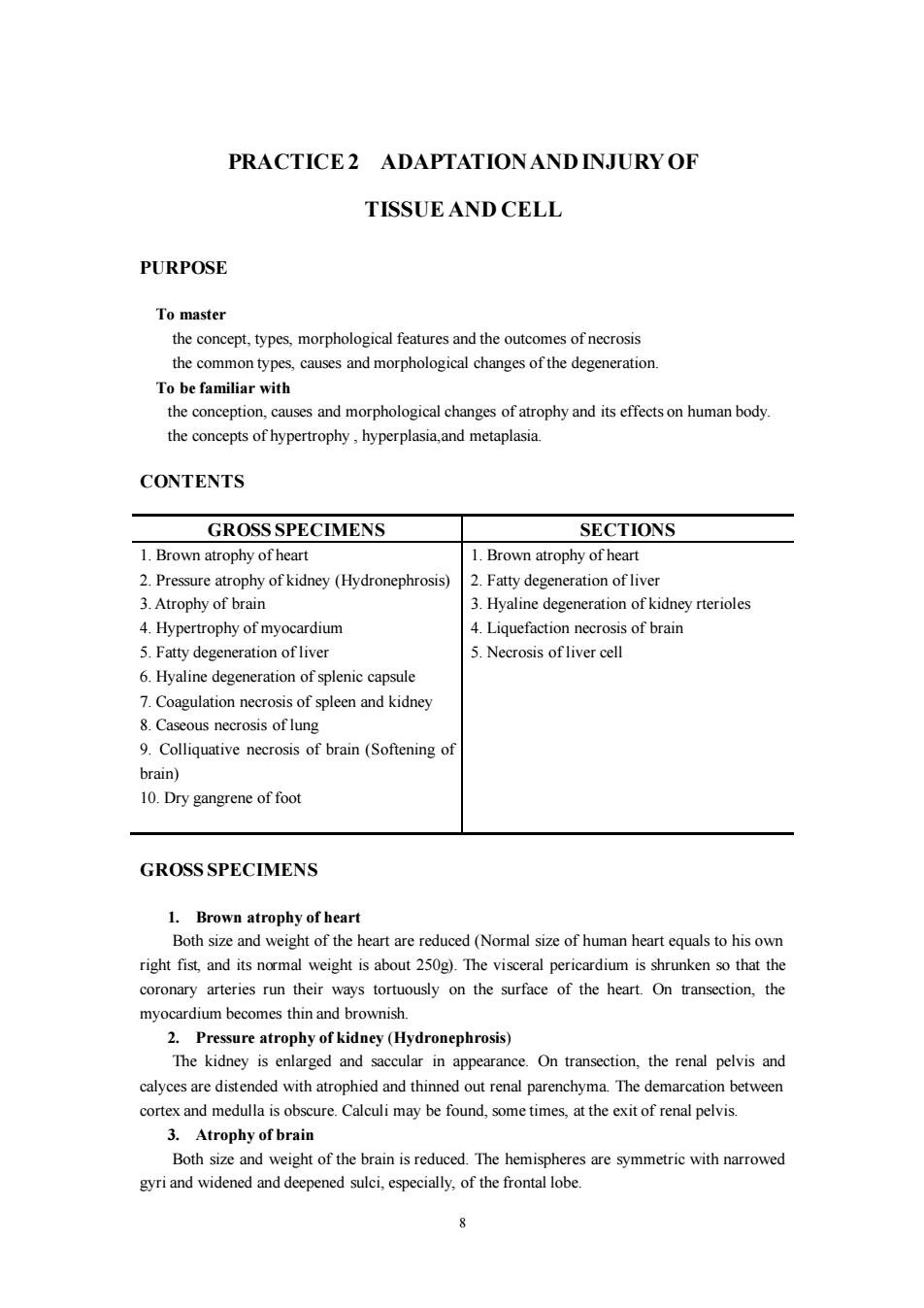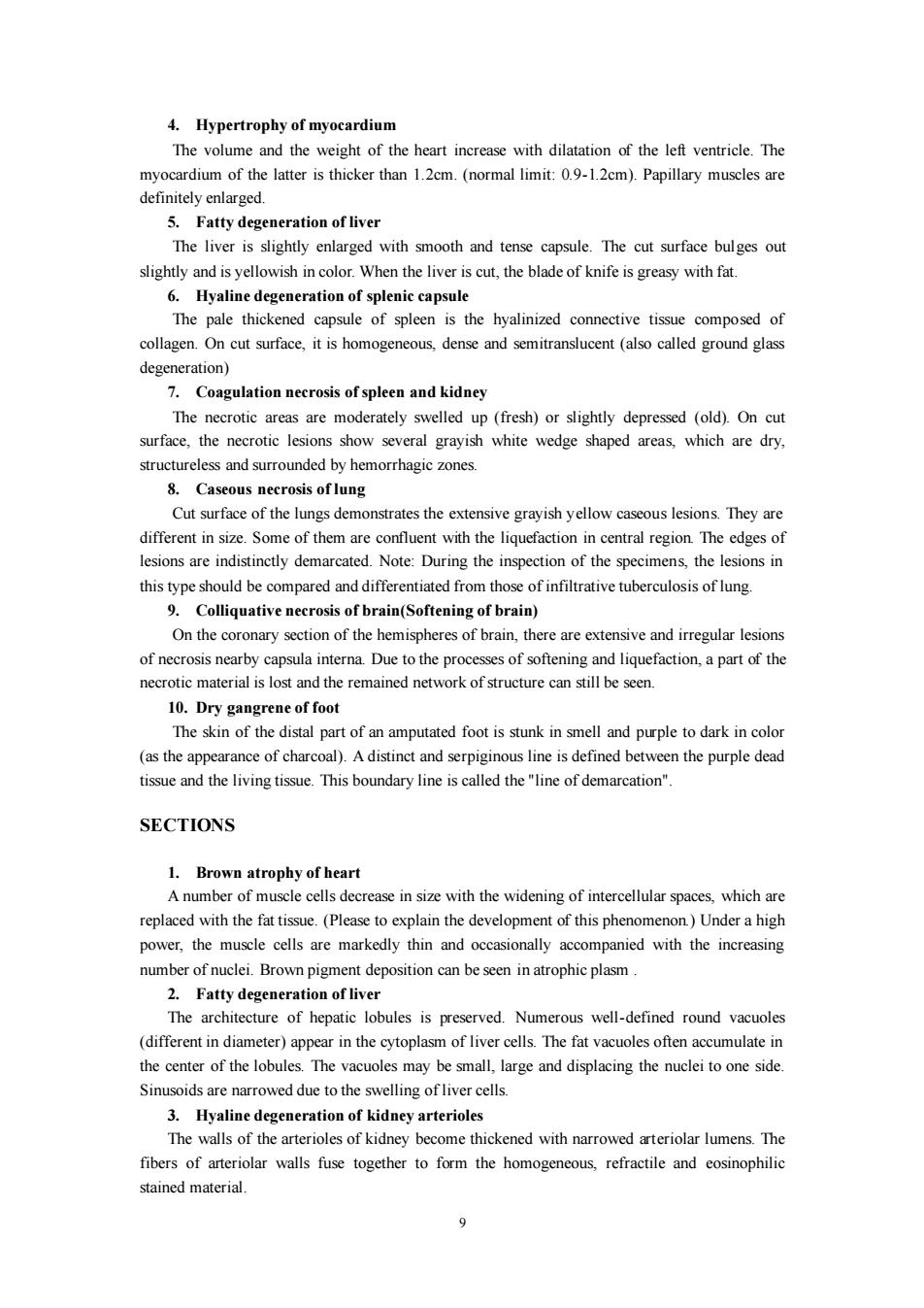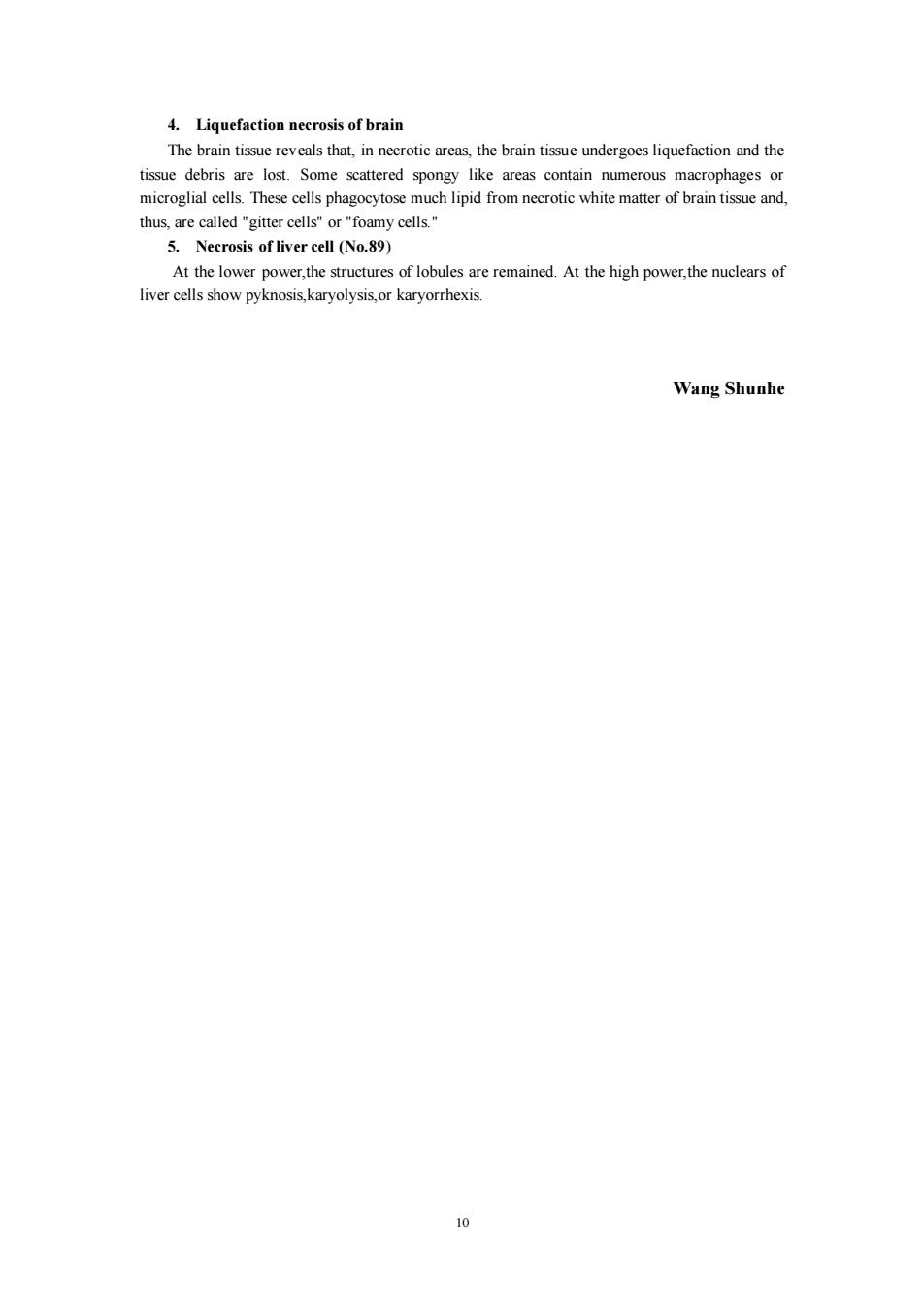
phagocytic cells.Sometimes the congestion is accompanied with the proliferation of fibrous tissue 3.Mixed thrombus Fresh thrombi can be seen in veins or in cardiac cavity.They are formed by pale lines interwinding with dark red layers of erythrocytes,that is called"mixed thrombus."At one end of the mixed thrombus is in continuum with darkbrown blood clot,which is known as "red thrombus.The thrombus is adhered tightly to the intima of vein orendocardium. of pulm ary arter门 The embolus lodging in the main pulmonary artery comes probably from large veins of lower limbs or pelvis.How do you differentiate the embolism from the thrombosis of a pulmonary artery? 5.Ischemic (anemic)infarct of the spleen dry and fm.the to the hilum of the organ. hemorrhagic zone surrounding the lesions can be seen.Besides,the spleen is markedly congested 6.Ischemic (anemic)infarct of the kidney The capsule of the kidney has been torn off.On the cut surface there are several dull.drv whitish yellow lesions,poorly defined and surrounded by dark brown hemrhagic zone.Thes wedge shape in with apex pointing 7.Infarct of the brain(Softening of brain) One or several necrotic lesions of brain undergo the liquefaction.The softened or liquefied brain tissue and debris are removed by macrophages and,besides,diffused into venules nearby, eaving the defects in brain tissue. 8.Hem infar ts of the lung Several dark red or violet black lesions in different sizes can be seen on the cut surface of lung. These lesions are wedge shaped with the apex pointing to the hilum and the base to the pleura 9.Hemorrhagic infaret of the intestine The involved segment of small intestine is markedly swollen and thickened,and is well the norml part.wall is purpleor black in The fibrinous exudate 10.Acute appenditis This appendix was removed surgically.Seen here is acute appendicitis with yellow to tan exudate and hyperemia rather than a smooth glistening pale tan serosal surface.The small artery on the surface is dilated 11.Hemorrhage oflung The lung become weighted ,black and solid.The cut surface become solid too,because the alveoli were filled red blood oells and other exudates such as fibrin and white blood cells.The changes were diffuse or local. SECTIONS 1.Chronic congestion of theliver The archt ture of the hepatic lobules is sill maintained.There are lage amounts of erythrocytes in dilated central veins and sinusoids nearby.The hepatic cords become thin and ever disappear because of the pressure by the dilated sinusoids.In the peripheral zone of the lobules, 6
6 phagocytic cells. Sometimes the congestion is accompanied with the proliferation of fibrous tissue of alveolar walls, resulting in "brown induration" of lungs. 3. Mixed thrombus Fresh thrombi can be seen in veins or in cardiac cavity. They are formed by pale lines interwinding with dark red layers of erythrocytes, that is called "mixed thrombus." At one end of the mixed thrombus is in continuum with darkbrown blood clot, which is known as "red thrombus." The thrombus is adhered tightly to the intima of vein or endocardium. 4. Embolism of pulmonary artery The embolus lodging in the main pulmonary artery comes probably from large veins of lower limbs or pelvis. How do you differentiate the embolism from the thrombosis of a pulmonary artery? 5. Ischemic (anemic) infarct of the spleen Cut surface of the spleen contains solitary or multiple wedge shaped or irregular lesions with gray, dry and firm consistency. The apex of the lesion points to the hilum of the organ. A hemorrhagic zone surrounding the lesions can be seen. Besides, the spleen is markedly congested. 6. Ischemic (anemic) infarct of the kidney The capsule of the kidney has been torn off. On the cut surface there are several dull, dry whitish yellow lesions, poorly defined and surrounded by dark brown hemorrhagic zone. These lesions are wedge shaped being with apex pointing to renal hilum. 7. Infarct of the brain (Softening of brain) One or several necrotic lesions of brain undergo the liquefaction. The softened or liquefied brain tissue and debris are removed by macrophages and, besides, diffused into venules nearby, leaving the defects in brain tissue. 8. Hemorrhagic infarcts of the lung Several dark red or violet black lesions in different sizes can be seen on the cut surface of lung. These lesions are wedge shaped with the apex pointing to the hilum and the base to the pleura. 9. Hemorrhagic infarct of the intestine The involved segment of small intestine is markedly swollen and thickened, and is well demarcated from the normal part. The intestinal wall is purple or black in color. The serosal surface is dry and rough as a result of covering with fibrinous exudate. 10. Acute appenditis This appendix was removed surgically. Seen here is acute appendicitis with yellow to tan exudate and hyperemia, rather than a smooth, glistening pale tan serosal surface. The small artery on the surface is dilated. 11. Hemorrhage of lung The lung become weighted ,black and solid.The cut surface become solid too,because the alveoli were filled red blood cells and other exudates,such as fibrin and white blood cells.The changes were diffuse or local. SECTIONS 1. Chronic congestion of the liver The architecture of the hepatic lobules is still maintained. There are large amounts of erythrocytes in dilated central veins and sinusoids nearby. The hepatic cords become thin and even disappear because of the pressure by the dilated sinusoids. In the peripheral zone of the lobules

the cell cords are intact and sinusoids normal.but fatty degeneration of liver cell is evident.In ,the congested regions ink other,and the portal areas Acute congestion of lung The archtecture of lung was maintainted.Dilated blood vessels containing abundant RBCs Serumal exudates in the alveoli was stained pink by hematoxylin and eosin.Red blood cells can be also seen in the alveoli. 3.Chronic congestion of lung Dilated blood vessels containing abundant RBCs Scattered RBCs may be found in the alveoli due to diapedesis which lead to Hemosiderin-laden macrophages (heart failure cells) appearing within a few days Protein-rich edema fluid may also be present 4.Mixed thrombus Section shows that thrombi are within two vessels of lung tissue.The thrombi are composed surfaces.Fibrin strands are festooned loosely between platelet layers.Numerous orange tinge erythrocytes are entangled within the meshes of fibrin network With the high power.the platelet masses appear as finely granular material.A great number of leukocytes are meshed in them. Fibrin networks with entangled erythrocytes can be observed between the platelet masses. 5.Isch A pale red wedge shaped area is sumounded by a highly cellular zone,outside of which there is a thin rim of erythrocytes.In the wedge shaped area,typical changes of coagulative necrosis are seen:the out lines of glomeruli and tubules are still maintained,but the cell nuclei disappeared and the cytoplasm is either eosinophilic homogeneous or finely granular.A large number of ombotic embolus can be found in the lumen of one sule is a thin rim kidney tissue 6.Hemorrhagic infaret of the lung A triangle shaped.dense and pink stained area is revealed in lung tissue.The architecture of lung tissue in this area is barely discernible.since most nuclei have disappeared or covered by hemorrhage.This is the area of hemorrhagic infarct of lung tissue.The alveolar cavities within the area of in nfarct are flooded with ting in arked consolidatio be inan individual small blood the of which the architecture of lung tissue is still remained.The pleura covering the infarct become thickened due to the proliferation of fibrous tissue. ANIMAL EXPERIMENT To demonstrate air embolism in rabbit. Wang Shunhe
7 the cell cords are intact and sinusoids normal, but fatty degeneration of liver cell is evident. In some areas, the congested regions link with each other, and surround the portal areas. 2. Acute congestion of lung The archtecture of lung was maintainted. Dilated blood vessels containing abundant RBC's. Serumal exudates in the alveoli was stained pink by hematoxylin and eosin. Red blood cells can be also seen in the alveoli. 3. Chronic congestion of lung Dilated blood vessels containing abundant RBC's Scattered RBC's may be found in the alveoli due to diapedesis which lead to Hemosiderin-laden macrophages (heart failure cells) appearing within a few days Protein-rich edema fluid may also be present 4. Mixed thrombus Section shows that thrombi are within two vessels of lung tissue. The thrombi are composed of pink stained homogeneous masses (platelet layers) with numerous neutrophils attaching to their surfaces. Fibrin strands are festooned loosely between platelet layers. Numerous orange tinged erythrocytes are entangled within the meshes of fibrin network. With the high power, the platelet masses appear as finely granular material. A great number of leukocytes are meshed in them. Fibrin networks with entangled erythrocytes can be observed between the platelet masses. 5. Ischemic (anemic) infarct of kidney A pale red wedge shaped area is surrounded by a highly cellular zone, outside of which there is a thin rim of erythrocytes. In the wedge shaped area, typical changes of coagulative necrosis are seen: the out lines of glomeruli and tubules are still maintained, but the cell nuclei disappeared and the cytoplasm is either eosinophilic homogeneous or finely granular. A large number of neutrophils are found in the cellular zone. A thrombotic embolus can be found in the lumen of one small artery. Just beneath the capsule is a thin rim of living kidney tissue. 6. Hemorrhagic infarct of the lung A triangle shaped, dense and pink stained area is revealed in lung tissue. The architecture of lung tissue in this area is barely discernible, since most nuclei have disappeared or covered by hemorrhage. This is the area of hemorrhagic infarct of lung tissue. The alveolar cavities within the area of infarct are flooded with innumerable erythrocytes, resulting in marked consolidation of the lesion. Thrombus can be observed in an individual small blood vessel within the lesion, outside of which the architecture of lung tissue is still remained. The pleura covering the infarct become thickened due to the proliferation of fibrous tissue. ANIMAL EXPERIMENT To demonstrate air embolism in rabbit. Wang Shunhe

PRACTICE2 ADAPTATIONAND INJURY OF TISSUE AND CELL PURPOSE To master the types,morphological features and the the common types,causes and morphological changes of the degeneration To be familiar with the conception,causes and morphological changes of atrophy and its effectson human body. the concepts of hypertrophy,hyperplasia,and metaplasia. CONTENTS GROSS SPECIMENS SECTIONS 1.Brown atrophy ofheart 1.Brown atrophy of heart 2.Pressure atrophy of kidney (Hvdronephrosis) 2.Fatty degeneration of liver 3.Atrophy of brain 3.Hyaline degeneration of kidney rterioles n ne osis of brai 5.Fatty degeneration oflive 5.Necrosis of liver cell 6.Hyaline degeneration of splenic capsule 7.Coagulation necrosis of spleen and kidney 8 Caseous necrosis of lung 9.Colliquative necrosis of brain(Softening of brain) 10.Dry gangrene of foot GROSS SPECIMENS 1.Brown atrophy of hear Both size and weight of the heart are reduced(Normal size of human heart equals to his own right fist,and its normal weight is about 250g).The visceral pericardium is shrunken so that the coronary arteries run their ways tortuously on the surface of the heart.On transection.the myocardium becomes thin and brownish. 2.Pressure hy of kidney(Hydronephrosis) The kidney is enlarged and saccular in appearance.On transection,the renal pelvis and calyces are distended with atrophied and thinned out renal parenchyma.The demarcation between cortex and medulla is obscure.Calculi may be found,some times,at the exit of renal pelvis. 3.Atrophy of brain Both siz and eight of the brain isreduced.The hemispheres are symmetric with narrowed gyri and widened and deepened ,of the frontal obe
8 PRACTICE 2 ADAPTATION AND INJURY OF TISSUE AND CELL PURPOSE To master the concept, types, morphological features and the outcomes of necrosis the common types, causes and morphological changes of the degeneration. To be familiar with the conception, causes and morphological changes of atrophy and its effects on human body. the concepts of hypertrophy , hyperplasia,and metaplasia. CONTENTS GROSS SPECIMENS SECTIONS 1. Brown atrophy of heart 2. Pressure atrophy of kidney (Hydronephrosis) 3. Atrophy of brain 4. Hypertrophy of myocardium 5. Fatty degeneration of liver 6. Hyaline degeneration of splenic capsule 7. Coagulation necrosis of spleen and kidney 8. Caseous necrosis of lung 9. Colliquative necrosis of brain (Softening of brain) 10. Dry gangrene of foot 1. Brown atrophy of heart 2. Fatty degeneration of liver 3. Hyaline degeneration of kidney rterioles 4. Liquefaction necrosis of brain 5. Necrosis of liver cell GROSS SPECIMENS 1. Brown atrophy of heart Both size and weight of the heart are reduced (Normal size of human heart equals to his own right fist, and its normal weight is about 250g). The visceral pericardium is shrunken so that the coronary arteries run their ways tortuously on the surface of the heart. On transection, the myocardium becomes thin and brownish. 2. Pressure atrophy of kidney (Hydronephrosis) The kidney is enlarged and saccular in appearance. On transection, the renal pelvis and calyces are distended with atrophied and thinned out renal parenchyma. The demarcation between cortex and medulla is obscure. Calculi may be found, some times, at the exit of renal pelvis. 3. Atrophy of brain Both size and weight of the brain is reduced. The hemispheres are symmetric with narrowed gyri and widened and deepened sulci, especially, of the frontal lobe

4.Hypertrophy of myocardium The voume and the weight of the heart increase with dilatation of the left ventricle.The myocardium of the latter is thicker than 1.2cm.(normal limit:09-1.2cm).Papillary muscles are definitely enlarged. 5.Fatty degeneration of liver The liver is slightly enlarged with smooth and tense capsule.The cut surface bulges out slightly and is the liver is cutthe blade of knife is greasy with fat Hyaline degeneration of splenic capsule The pale thickened capsule of spleen is the hyalinized connective tissue composed of collagen.On cut surface,it is homogeneous,dense and semitranslucent(also called ground glass degeneration) 7.Coagulation necrosis of spleen and kidney The necrotic areas are moderately swelled up (fresh)or slightly depressed (old)On cut surface,the necrotic lesions show several grayish white wedge shaped areas,which are dry. structureless and surrounded by hemorrhagic zones. 8.Caseous necrosis oflung Cut surface of the lungs demonstrates the extensive grayish yellow caseous lesions.They are e them with the liquefa central regi The edges esions are indistinctly demarcated.Note:During the inspection of,the esons in this type should be compared and differentiated from those of infiltrative tuberculosis of lung. 9.Colliquative necrosis of brain(Softening of brain) On the coronary section of the hemispheres of brain.there are extensive and irregular lesions ork of structure cans till be seer 10.Dry gangrene of foot The skin of the distal part of an amputated foot is stunk in smell and purple to dark in color (as the appearance of charcoal).Adistinct and serpiginous line is defined between the purple dead tissue and the living tissue.This boundaryine is called of demarcation" SECTIONS 1.Brown atrophy of heart Anumber of muscle cells decrease in size with the widening of intercellular spaces,which are replaced with the fat tissue.(Please to explain the development of this phenomenon)Under a high power.the muscle cells are markedly thin and occasionally accompanied with the increasing 2.Fatty degenera ation of liver The architecture of hepatic lobules is preserved.Numerous well-defined round vacuoles (different in diameter)appear in the cytoplasm of liver cells.The fat vacuoles often accumulate in the center of the lobules.The vacuoles may be small,large and displacing the nuclei to one side Sinusoids are narrowed due to the swelling ofliver cells 3.Hyaline degeneration of kidney arterioe The walls of the arterioles of kidney become thickened with narrowed arteriolar lumens.The fibers of arteriolar walls fuse together to form the homogeneous,refractile and eosinophilic stained material. 9
9 4. Hypertrophy of myocardium The volume and the weight of the heart increase with dilatation of the left ventricle. The myocardium of the latter is thicker than 1.2cm. (normal limit: 0.9-1.2cm). Papillary muscles are definitely enlarged. 5. Fatty degeneration of liver The liver is slightly enlarged with smooth and tense capsule. The cut surface bulges out slightly and is yellowish in color. When the liver is cut, the blade of knife is greasy with fat. 6. Hyaline degeneration of splenic capsule The pale thickened capsule of spleen is the hyalinized connective tissue composed of collagen. On cut surface, it is homogeneous, dense and semitranslucent (also called ground glass degeneration) 7. Coagulation necrosis of spleen and kidney The necrotic areas are moderately swelled up (fresh) or slightly depressed (old). On cut surface, the necrotic lesions show several grayish white wedge shaped areas, which are dry, structureless and surrounded by hemorrhagic zones. 8. Caseous necrosis of lung Cut surface of the lungs demonstrates the extensive grayish yellow caseous lesions. They are different in size. Some of them are confluent with the liquefaction in central region. The edges of lesions are indistinctly demarcated. Note: During the inspection of the specimens, the lesions in this type should be compared and differentiated from those of infiltrative tuberculosis of lung. 9. Colliquative necrosis of brain(Softening of brain) On the coronary section of the hemispheres of brain, there are extensive and irregular lesions of necrosis nearby capsula interna. Due to the processes of softening and liquefaction, a part of the necrotic material is lost and the remained network of structure can still be seen. 10. Dry gangrene of foot The skin of the distal part of an amputated foot is stunk in smell and purple to dark in color (as the appearance of charcoal). A distinct and serpiginous line is defined between the purple dead tissue and the living tissue. This boundary line is called the "line of demarcation". SECTIONS 1. Brown atrophy of heart A number of muscle cells decrease in size with the widening of intercellular spaces, which are replaced with the fat tissue. (Please to explain the development of this phenomenon.) Under a high power, the muscle cells are markedly thin and occasionally accompanied with the increasing number of nuclei. Brown pigment deposition can be seen in atrophic plasm . 2. Fatty degeneration of liver The architecture of hepatic lobules is preserved. Numerous well-defined round vacuoles (different in diameter) appear in the cytoplasm of liver cells. The fat vacuoles often accumulate in the center of the lobules. The vacuoles may be small, large and displacing the nuclei to one side. Sinusoids are narrowed due to the swelling of liver cells. 3. Hyaline degeneration of kidney arterioles The walls of the arterioles of kidney become thickened with narrowed arteriolar lumens. The fibers of arteriolar walls fuse together to form the homogeneous, refractile and eosinophilic stained material

4.Liquefaction necrosis of brain tisse debris ares Some scattered spongy like areas contain numerous macrophages or microglial cells.These cells phagocytose much lipid from necrotic white matter of brain tissue and, thus,are called"gitter cells"or"foamy cells" 5.Neerosis of liver cell (No.89) At the lower power,the structures of lobules are remained.At the high power,the nuclears of Wang Shunhe
10 4. Liquefaction necrosis of brain The brain tissue reveals that, in necrotic areas, the brain tissue undergoes liquefaction and the tissue debris are lost. Some scattered spongy like areas contain numerous macrophages or microglial cells. These cells phagocytose much lipid from necrotic white matter of brain tissue and, thus, are called "gitter cells" or "foamy cells." 5. Necrosis of liver cell (No.89) At the lower power,the structures of lobules are remained. At the high power,the nuclears of liver cells show pyknosis,karyolysis,or karyorrhexis. Wang Shunhe